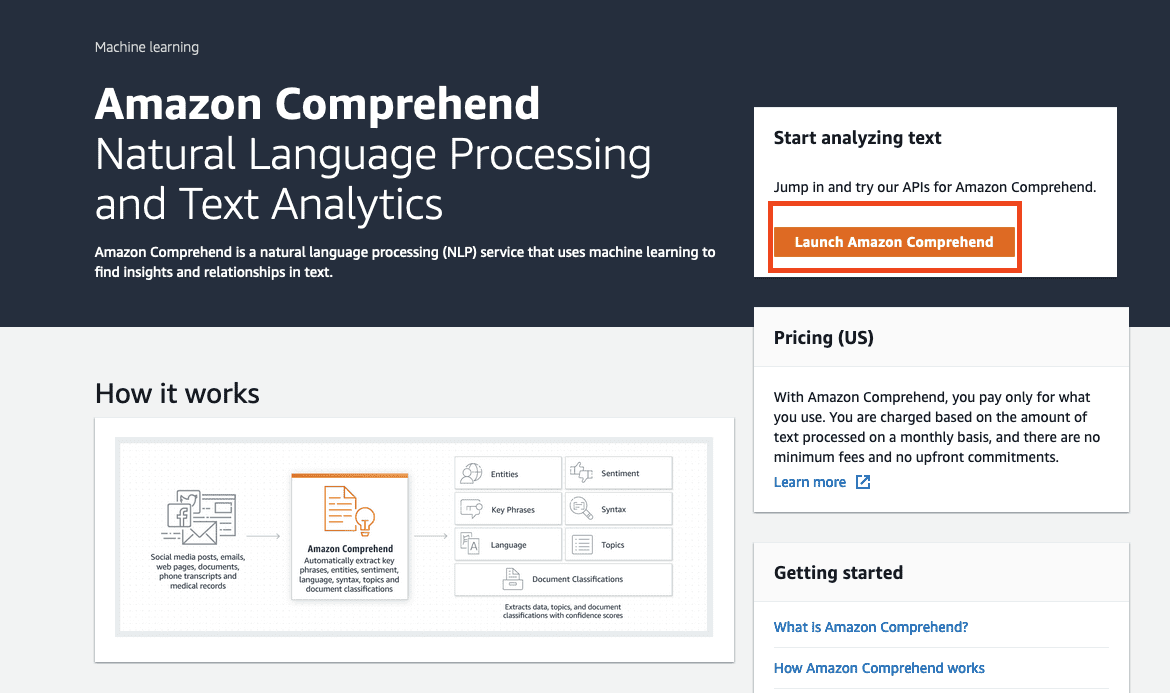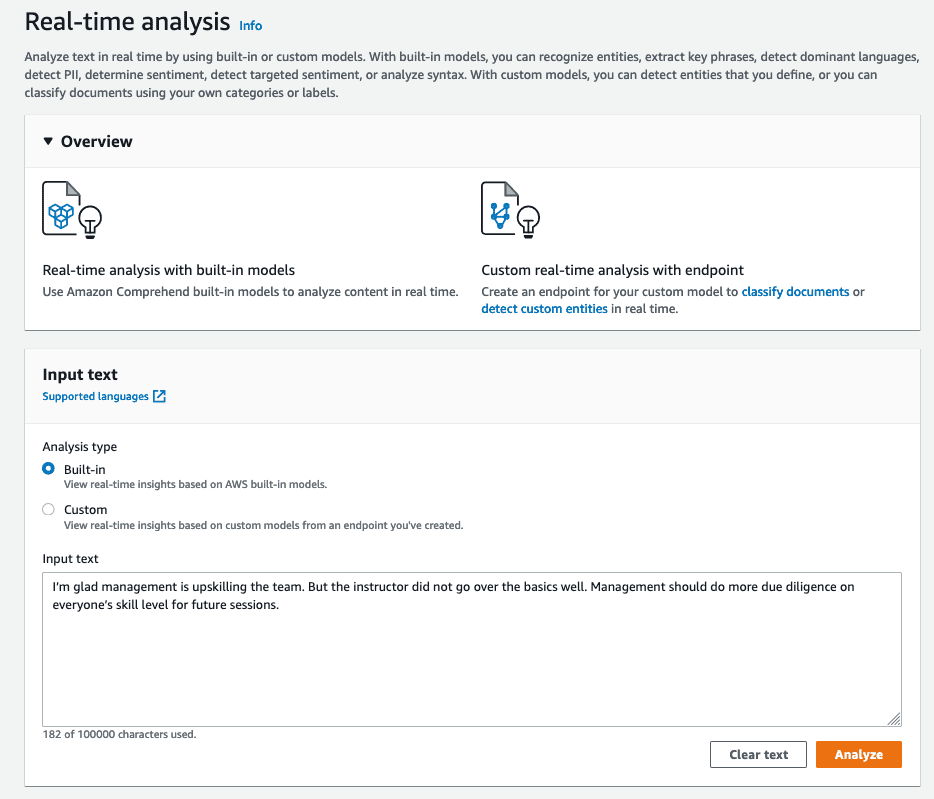Amazon Comprehend Targeted Sentiment adds synchronous support
Earlier this year, Amazon Comprehend, a natural language processing (NLP) service that uses machine learning (ML) to discover insights from text, launched the Targeted Sentiment feature. With Targeted Sentiment, you can identify groups of mentions (co-reference groups) corresponding to a single real-world entity or attribute, provide the sentiment associated with each entity mention, and offer the classification of the real-world entity based on a pre-determined list of entities.
Today, we’re excited to announce the new synchronous API for targeted sentiment in Amazon Comprehend, which provides a granular understanding of the sentiments associated with specific entities in input documents.
In this post, we provide an overview of how you can get started with the Amazon Comprehend Targeted Sentiment synchronous API, walk through the output structure, and discuss three separate use cases.
Targeted sentiment use cases
Real-time targeted sentiment analysis in Amazon Comprehend has several applications to enable accurate and scalable brand and competitor insights. You can use targeted sentiment for business-critical processes such as live market research, producing brand experience, and improving customer satisfaction.
The following is an example of using targeted sentiment for a movie review.
“Movie” is the primary entity, identified as type movie, and is mentioned two more times as “movie” and the pronoun “it.” The Targeted Sentiment API provides the sentiment towards each entity. Green refers to a positive sentiment, red for negative, and blue for neutral.
Traditional analysis provides sentiment of the overall text, which in this case is mixed. With targeted sentiment, you can get more granular insights. In this scenario, the sentiment towards the movie is both positive and negative: positive in regards to the actors, but negative in relation to the overall quality. This can provide targeted feedback for the film team, such as to exercise more diligence in script writing, but to consider the actors for future roles.
Prominent applications of real-time sentiment analysis will vary across industries. It includes extracting marketing and customer insights from live social media feeds, videos, live events, or broadcasts, understanding emotions for research purposes, or deterring cyberbullying. Synchronous targeted sentiment drives business value by providing real-time feedback within seconds so that you can make decisions in real time.
Let’s take a closer look at these various real-time targeted sentiment analysis applications and how different industries may use them:
- Scenario 1 – Opinion mining of financial documents to determine sentiment towards a stock, person, or organization
- Scenario 2 – Real-time call center analytics to determine granular sentiment in customer interactions
- Scenario 3 – Monitoring organization or product feedback across social media and digital channels, and providing real-time support and resolutions
In the following sections, we discuss each use case in more detail.
Scenario 1: Financial opinion mining and trading signal generation
Sentiment analysis is crucial for market-makers and investment firms when building trading strategies. Determining granular sentiment can help traders infer what reaction the market may have towards global events, business decisions, individuals, and industry direction. This sentiment can be a determining factor on whether to buy or sell a stock or commodity.
To see how we can use the Targeted Sentiment API in these scenarios, let’s look at a statement from Federal Reserve Chair Jerome Powell on inflation.
As we can see in the example, understanding the sentiment towards inflation can inform a buy or sell decision. In this scenario, it can be inferred from the Targeted Sentiment API that Chair Powell’s opinion on inflation is negative, and this is most likely going to result in higher interest rates slowing economic growth. For most traders, this could result in a sell decision. The Targeted Sentiment API can provide traders faster and more granular insight than a traditional document review, and in an industry where speed is crucial, it can result in substantial business value.
The following is a reference architecture for using targeted sentiment in financial opinion mining and trading signal generation scenarios.
Scenario 2: Real-time contact center analysis
A positive contact center experience is crucial in delivering a strong customer experience. To help ensure positive and productive experiences, you can implement sentiment analysis to gauge customer reactions, the changing customer moods through the duration of the interaction, and the effectiveness of contact center workflows and employee training. With the Targeted Sentiment API, you can get granular information within your contact center sentiment analysis. Not only can we determine the sentiment of the interaction, but now we can see what caused the negative or positive reaction and take the appropriate action.
We demonstrate this with the following transcripts of a customer returning a malfunctioning toaster. For this example, we show sample statements that the customer is making.
As we can see, the conversation starts off fairly negative. With the Targeted Sentiment API, we’re able to determine the root cause of the negative sentiment and see it’s regarding a malfunctioning toaster. We can use this information to run certain workflows, or route to different departments.
Through the conversation, we can also see the customer wasn’t receptive to the offer of a gift card. We can use this information to improve agent training, reevaluate if we should even bring up the topic in these scenarios, or decide if this question should only be asked with a more neutral or positive sentiment.
Lastly, we can see that the service that was provided by the agent was received positively even though the customer was still upset about the toaster. We can use this information to validate agent training and reward strong agent performance.
The following is a reference architecture incorporating targeted sentiment into real-time contact center analytics.
Scenario 3: Monitoring social media for customer sentiment
Social media reception can be a deciding factor for product and organizational growth. Tracking how customers are reacting to company decisions, product launches, or marketing campaigns is critical in determining effectiveness.
We can demonstrate how to use the Targeted Sentiment API in this scenario by using Twitter reviews of a new set of headphones.
In this example, there are mixed reactions to the launch of the headphones, but there is a consistent theme of the sound quality being poor. Companies can use this information to see how users are reacting to certain attributes and see where product improvements should be made in future iterations.
The following is a reference architecture using the Targeted Sentiment API for social media sentiment analysis.
Get started with Targeted Sentiment
To use targeted sentiment on the Amazon Comprehend console, complete the following steps:
- On the Amazon Comprehend console, choose Launch Amazon Comprehend.

- For Input text, enter any text that you want to analyze.
- Choose Analyze.

After the document has been analyzed, the output of the Targeted Sentiment API can be found on the Targeted sentiment tab in the Insights section. Here you can see the analyzed text, each entity’s respective sentiment, and the reference group it’s associated with.
In the Application integration section, you can find the request and response for the analyzed text.
Programmatically use Targeted Sentiment
To get started with the synchronous API programmatically, you have two options:
- detect-targeted-sentiment – This API provides the targeted sentiment for a single text document
- batch-detect-targeted-sentiment – This API provides the targeted sentiment for a list of documents
You can interact with the API with the AWS Command Line Interface (AWS CLI) or through the AWS SDK. Before we get started, make sure that you have configured the AWS CLI, and have the required permissions to interact with Amazon Comprehend.
The Targeted Sentiment synchronous API requires two request parameters to be passed:
- LanguageCode – The language of the text
- Text or TextList – The UTF-8 text that is processed
The following code is an example for the detect-targeted-sentiment API:
The following is an example for the batch-detect-targeted-sentiment API:
Now let’s look at some sample AWS CLI commands.
The following code is an example for the detect-targeted-sentiment API:
The following is an example for the batch-detect-targeted-sentiment API:
The following is a sample Boto3 SDK API call:
The following is an example of the detect-targeted-sentiment API:
The following is an example of the batch-detect-targeted-sentiment API:
For more details about the API syntax, refer to the Amazon Comprehend Developer Guide.
API response structure
The Targeted Sentiment API provides a simple way to consume the output of your jobs. It provides a logical grouping of the entities (entity groups) detected, along with the sentiment for each entity. The following are some definitions of the fields that are in the response:
- Entities – The significant parts of the document. For example,
Person,Place,Date,Food, orTaste. - Mentions – The references or mentions of the entity in the document. These can be pronouns or common nouns such as “it,” “him,” “book,” and so on. These are organized in order by location (offset) in the document.
- DescriptiveMentionIndex – The index in
Mentionsthat gives the best depiction of the entity group. For example, “ABC Hotel” instead of “hotel,” “it,” or other common noun mentions. - GroupScore – The confidence that all the entities mentioned in the group are related to the same entity (such as “I,” “me,” and “myself” referring to one person).
- Text – The text in the document that depicts the entity.
- Type – A description of what the entity depicts.
- Score – The model confidence that this is a relevant entity.
- MentionSentiment – The actual sentiment found for the mention.
- Sentiment – The string value of positive, neutral, negative, or mixed.
- SentimentScore – The model confidence for each possible sentiment.
- BeginOffset – The offset into the document text where the mention begins.
- EndOffset – The offset into the document text where the mention ends.
For a more detailed breakdown, refer to Extract granular sentiment in text with Amazon Comprehend Targeted Sentiment or Output file organization.
Conclusion
Sentiment analysis remains crucial for organizations for a myriad of reasons—from tracking customer sentiment over time for businesses, to inferring whether a product is liked or disliked, to understanding opinions of users of a social network towards certain topics, or even predicting the results of campaigns. Real-time targeted sentiment can be effective for businesses, allowing them to go beyond overall sentiment analysis to explore insights to drive customer experiences using Amazon Comprehend.
To learn more about Targeted Sentiment for Amazon Comprehend, refer to Targeted sentiment.
About the authors
 Raj Pathak is a Solutions Architect and Technical advisor to Fortune 50 and Mid-Sized FSI (Banking, Insurance, Capital Markets) customers across Canada and the United States. Raj specializes in Machine Learning with applications in Document Extraction, Contact Center Transformation and Computer Vision.
Raj Pathak is a Solutions Architect and Technical advisor to Fortune 50 and Mid-Sized FSI (Banking, Insurance, Capital Markets) customers across Canada and the United States. Raj specializes in Machine Learning with applications in Document Extraction, Contact Center Transformation and Computer Vision.
 Wrick Talukdar is a Senior Architect with Amazon Comprehend Service team. He works with AWS customers to help them adopt machine learning on a large scale. Outside of work, he enjoys reading and photography.
Wrick Talukdar is a Senior Architect with Amazon Comprehend Service team. He works with AWS customers to help them adopt machine learning on a large scale. Outside of work, he enjoys reading and photography.
Tags: Archive
















Leave a Reply